#trait: Ankylosaur
Explore tagged Tumblr posts
Text

Monochromon EX7-033 by koki from EX-07 Extra Booster Digimon Liberator
This card is another reference to the old pendulum artworks!
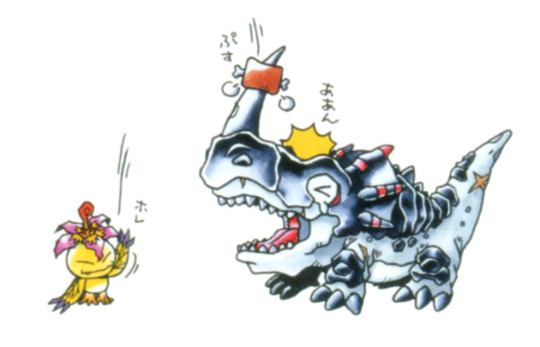
[Palmon: Here ya go | Monochromon: aah!]
#digimon#digimon tcg#digimon card game#digisafe#デジカ#digica#DCG#Monochromon#koki#EX7#digimon references#digimon card#Lv4#color: green#type: data#trait: Ankylosaur#trait: NSp#Nature Spirits#trait: dinosaur#num: 04#co starring Tanemon Palmon Gotsumon
434 notes
·
View notes
Note
how does 'all dinosaurs are birds' work...? i get 'all birds are dinosaurs', that's easy stuff. but denoting the entirety of dinosauria, avian and not, as synonymous with aves?
All are in "Pan-Aves", ie, the group of animals that are closer to Birds than to Any Other Living Group
Anything in Pan-Aves can *legally* be called a bird
Even beyond that, Dinosaurs specifically have extremely bird like traits, more so than anything else: - they ancestrally have feathers, complex ones, and feathers show up throughout the group - they have the Birdie Posture (open acetabulum, legs directly beneath the body) - many have bird like feet (Three toes walked upon digitigradedly) (and there are birds that don't even have that today) - They were all functionally warm blooded / active animals, and probably all had four chambered hearts (based on crocodilians as well as birds) - they nest like birds (Maiasaura basically had a seagull nest colony) - they were musical like birds (complex larynx in ankylosaurs, musical instruments on hadrosaur heads...) - they had display structures like birds (so many display structures I can't list them) - they had scales like bird scales - beaks show up in all clades and were evolved multiple times throughout dinosaurs - they all had lightweight but strong bones. - Saurischians also had avian breathing systems and hollow bones like birds - they have flexible ankles like birds and were extremely agile - they probably had higher neuronal density, like birds - any behaviors we are able to determine from the fossil record are very bird like - many had full on wings like birds (Maniraptoriformes) and the point at which flight evolved is earlier than we used to think (Velociraptor is a flightless bird.)
so... yeah.
the only reason anyone calls them "big lizards" is because we were wrong before.
98 notes
·
View notes
Text

[ The fossilized cervical vertebra and overlaying osteoderms of the new archosaur shown in a photograph, line drawing, and a computed tomography (CT) rendering model with the osteoderms and matrix removed (bottom). ]
"Researchers have described a new species of armored reptile that lived near the time of the first appearance of dinosaurs. With bony plates on its backbone, this archosaur fossil reveals that armor was a boomerang trait in the story of dinosaur and pterosaur evolution: the group's ancestors were armored, but this characteristic was lost and then independently re-evolved multiple times later among specialized dinosaurs like ankylosaurs, stegosaurs, and others. The study is published today in the Zoological Journal of the Linnean Society. "We are just starting to understand that there were many dinosaur-like creatures across the planet well before dinosaurs evolved," said the study's lead author Sterling Nesbitt, associate professor of geosciences at Virginia Tech and a research associate in the American Museum of Natural History's Division of Paleontology. "Dinosaurs were latecomers to the Triassic reptile party. They showed up well after many dinosaur-looking reptiles were established across our planet." Archosaurs are reptiles that are divided into two major branches: the bird-line, which includes pterosaurs and dinosaurs, including living dinosaurs (birds); and the crocodilian line, including crocodiles, alligators, caimans, and gharials. The newly described archosaur species, named Mambachiton fiandohana, is the earliest diverging member of the bird line of archosaur evolution."
Read more: "New archosaur species shows that precursor of dinosaurs and pterosaurs was armored"
#palaeoblr#Palaeontology#Paleontology#Mambachiton fiandohana#Mambachiton#Article#Information#Prehistoric#Extinct#Mesozoic#Triassic#Fossil
81 notes
·
View notes
Text
A Hundred Some New ATOM Kaiju Pt. 2
We're continuing our showcase of ATOM kaiju who've been lingering in my "to ink and color" pile for years, and yep, it's more retrosaurs. Listen, I have to draw big dinosaur monsters frequently to make life worth living, ok? We'll get to some non-retrosaurs in... part 5, probably.
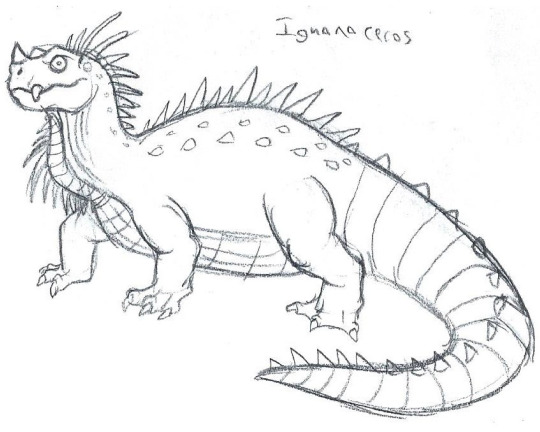
The last batch had a Crystal Palace Megalosaur-inspired kaiju in it, so we'll start this one with one inspired by the Crystal Palace Iguanodon.
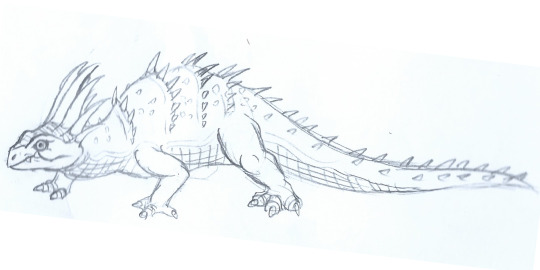
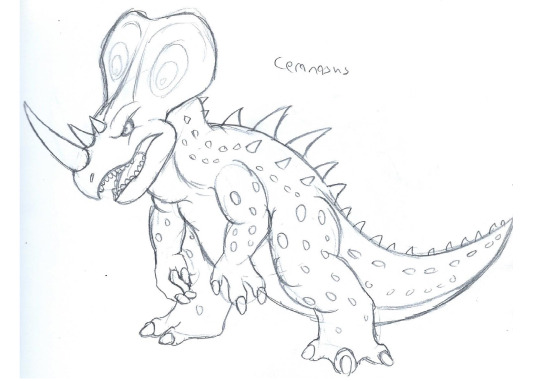

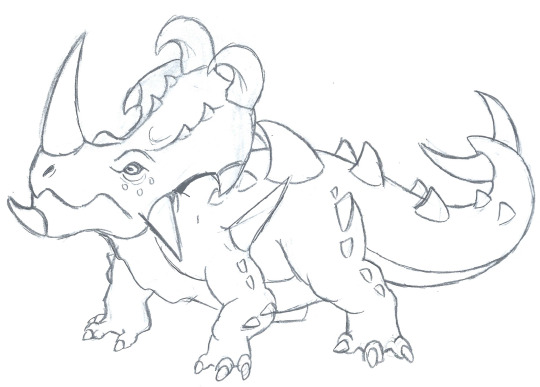

Next, some horned goliaths. The first is inspired by a very old styracosaurus toy I found that really emphasized the "lizard" approach of retro dinosaur designs, looking like a bearded dragon with an elaborate crest more than an actual styracosaur. Our second is loosely inspired by Armadon from Primal Rage and Triceramon from Digimon, being my stab at what a bipedal ceratopsian monster would look like. The remaining three are me just trying to have fun with ceratopsians the way I do with theropods.
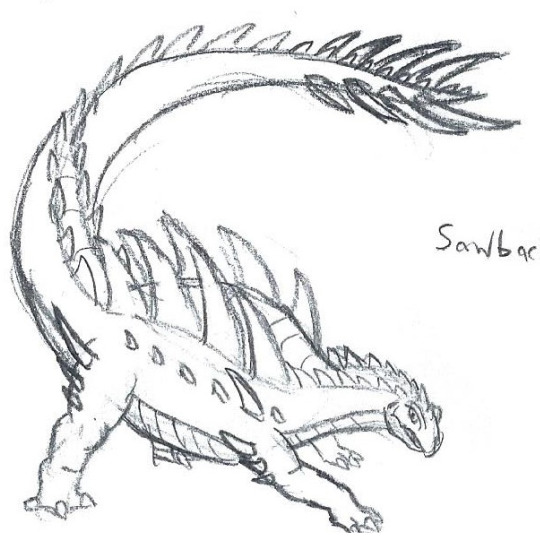

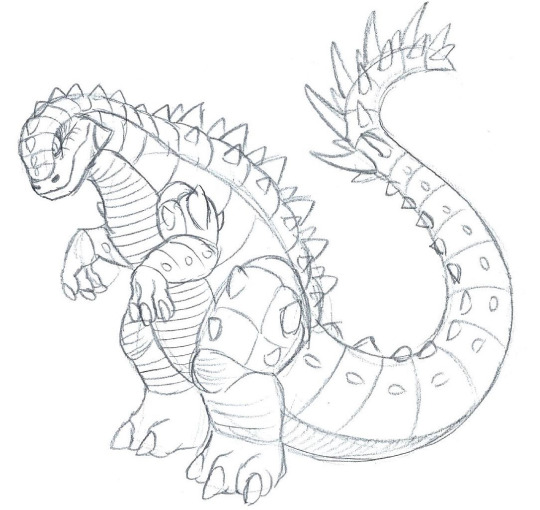
Stegronox was a fusion of stegosaur and ankylosaur traits in part to open up slots for more non-retrosaur kaiju in my cast of "core 50" kaiju for ATOM Volumes 1 and 2, so when working outside of those 50 I decided to do two retrosaur kaiju who focus on those two indvidually. The akylosaur's name is Ankylus, which is me being cheeky since that's basically what Anguirus's name would be if you translated it differently - they're both just "ankylosaurus" with a few less syllables. Then, for symmetry I suppose, I did an upright bipedal armored goliath to match the bipedal horned goliath, because "What if a four-legged creature stood on two legs" is a pretty easy way to make a monster feel distinct.
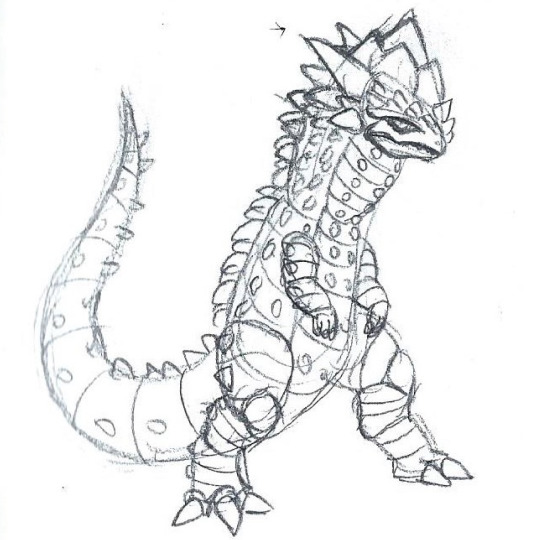
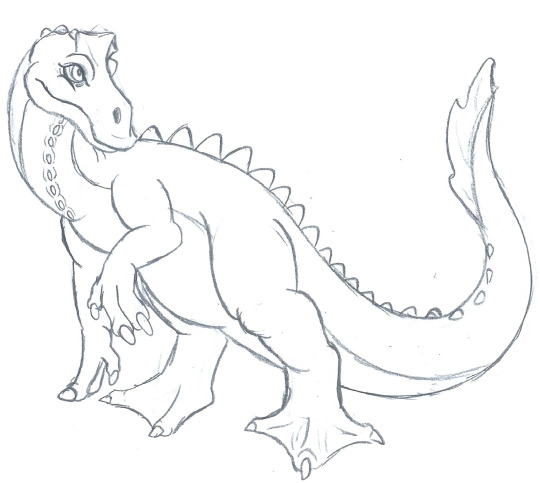
Like Stegronox, Pachydon was a combination of two different dinosaurs into one retrosaur to conserve slots in the core 50, and so I felt compelled to do two bonus retrosaur kaiju who took those two components and game them their proper due. We've got a helmeted goliath who takes the battering ram head reputation of pachycephalosaurs to a ludicous extreme, and a duckbill that particularly takes after Miasaura, which has always been my favorite hadrosaur.
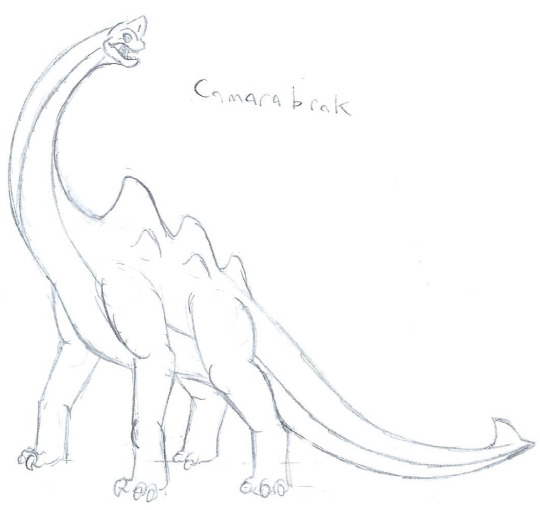
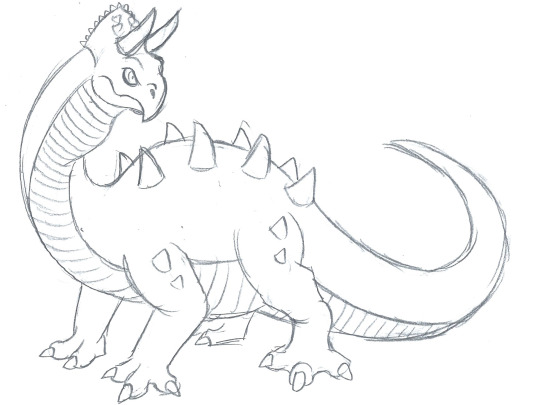
We'll close out this batch with some long-necked goliaths. The first, Camarabrak, is meant to be an equal to the other retrosaur kaiju, rather than an "immense even by kaiju standards" one like Bronton. Being bigger than big is, in my eyes, part of what makes Sauropods stand out in pop culture depictions of dinosaurs, which is why I made Bronton so tremendous compared to the others, but now that there's room for more sauropod monsters, we can have one that's in the same weight class as Tyrantis and pals.
The other long-necked goliath is Brontoceratops, which was inspired by a very early reconstruction of Triceratops (I think it may have even been by my ancestor, Edward Drinker Cope, but I can't find it anymore so who knows) that gave it a weirdly long neck. In ATOM canon, Brontoceratops's species does a sort of cuckoo-bird thing, putting their eggs in the nests of horned goliaths and letting them raise it. It'd feature in a story where Tricerak tries to find more of its kind and ends up adopting the baby Brontoceratops and raising it despite it not actually being a member of his kind.
32 notes
·
View notes
Note
Possible unique traits they could add to ancients to make them at least marginally more interesting, GO!
Tusks, elephant trunks, glowy markings like seawings from WOF, beards, molelike nose whiskers, hippo :3 mouths, long tongues, crab pincers, frog legs, massive curved ram horns, seal-like flippers and tails, extra wings like spirals, bony/spiny protrusions, shells, bird beaks and duck bills, single eye instead of multiple, prehensile tails, ankylosaur club tails, scorpion stings instead of/along side their tails, pterodactyl arm wings, chonky tsuchinoko shaped bodies, give them front arms but no back legs like a lindwurm, seahorse dragon?? only fins and no wings or legs, big t-rex looking dragon that has a massive head and short arms, a filter feeding sky whale shaped beast, unique shaped scales, more texture please!
Like you can literally google “types of dragons” and get all sorts of unique designs that come from mythology, pop culture, or are just stuff people design for fun! And there’s also so much inspiration from nature you can take! Animals are so weird and cool!
I also don’t get the people who whine that changing too much will make it “not look like a dragon” as if most of flight rising’s dragons look like traditional generic western dragons to begin with. Dragons aren’t real, have some fun with it!
PLEASE share more ideas in the comments because I love the possibilities of unique dragons!!
🌱
15 notes
·
View notes
Text
Deinons and Ape Kings
@glarnboudin
I decided to just make this a different post to keep from doing too many reblogs.
DEINONS
Deinon is the name given on Urobia to any significantly large saurian. For the most part the evolutionary relationships between species isn't too widely known, which means that Deinon is an unnatural group made up of animals that have the same general characteristics: Large and Reptilian. Since the size is one of the deciding factors, small theropods are frequently left out, instead being seen by most as strange birds. Small members of other clades can usually remain deinons since their similarities to their larger relatives and their differences from anything else is fairly obvious: A Protoceratops is clearly a small Triceratops, not any other sort of creature, therefor it's a small Deinon. A Velociraptor is a bird with a long tail.
Since the real life scientific names for dinosaurs don't exist on Urobia, the different groups have their own names, which are still somewhat being work-shopped but are more or less as follows:
Carnons/Tyrants: Large theropods, or any Retro or Pseudosaurs which superficially resemble them.
Brontons: Sauropods, or any Retro or Pseudosaurs which superficially resemble them.
Aegis: Ceratopsiand, or any Retro or Pseudosaurs which superficially resemble them.
Armores: Thyreophorans, or any Retro or Pseudosaurs which superficially resemble them. Stegosaurs are called Thagons or Speartails, Ankylosaurs are called Phalans or Shieldbacks.
Chattel: Large Ornithopods, or any Retro or Pseudosaurs which superficially resemble them.
For creatures which are dinosaurs but which aren't considered Deinons, Dromeosaurs are called Calcatrix, Raptors, Bandits, and/or Thieves. Small ornithischians are called Chitters.
Pterosaurs (and any Retro or Pseudosaurs which superficially resemble them) and Marine Reptiles are not always considered Deinons, but sometimes they are. The former are Dactyls and the latter are called Balhuts. Dactyls may also be called Jaculus/Jaculi, though keep in mind that the predatory serpent by this name also exists on Urobia. This can and has caused confusion, though no one can seem to agree as to which is worse to encounter, an actual Jaculus or a Quetzalcoatlus.
Retrosaurs are Pseudosuchians, Squamates, and other saurians which have evolved a superficially Dinosaurian build. These are classified based on the dinosaur group they resemble. A bipedal pseudosuchia carnivore would be a Carnon, for example.
Pseudosaurs are Dinosaurs which have undergone an altered Basilcock ritual (the reason why basilisks and cockatrices hatch out of bird eggs) to align themselves with Saurianhood. Like Retrosaurs they are named after the Dinosaur group they most resemble, though many are Carnons.
Pseudosaurs also have the following traits:
Forked tongues
Venomous
Can have scales, quills, or sparse feathers
Pronated wrists
Claws on all fingers, even if more than three fingers
Extra fingers can be common
Born female, can change sex into male if population requires
It is believed that most Pseudosaurs originate from a single transformed population of a dromaeosaur or primitive bird.
Ape Kings
Primates evolved normally on Urobia (or as normally as anything evolved on this world). Menfolk did not. At some point a Divine (class of beings to which angels, demons, and djinn belong) decided he wanted to create a race of warriors, and in order to do so he had his servant divines breed with apes. This would create the first Ape Kings (bigfoot and so on), which are basically Ape Nephilim. These ape kings would mate back with normal apes, until eventually the first Menfolk species was born, from which they would speciate out into humans, dwarves, elves, half men, goblins, ogres, etc.
Ape Kings as a species still exist, and their ancestry means they're still technically divine beings.
4 notes
·
View notes
Text

Jakapil kaniukura is some sort of something from the Late Cretaceous Candeleros Formation of Argentina. It was a small, armored ornithischian, only 1.5 meters long. Its traits place it as a possible basal thyreophoran, a relative of more derived forms like the stegosaurs and ankylosaurs, and similar to other primitive bipedal genera like Scutellosaurus and Scelidosaurus. The one major problem, however, is that these other basal forms lived almost 100 million years before Jakapil in the early Jurassic , indicating an enormously long ghost lineage preserved basal thyreophoran traits into the Cretaceous.
13 notes
·
View notes
Text
Hey just clarifying but beaked non-avian dinosaurs (like the above that is most likely a ceratopsian, not a bird sorry) are not the ancestors of birds. They're distant cousins at best. Beaked non-avian dinosaurs, with the exception of some proto-avian theropods, belong to the ornithischian (bird hipped) lineage of dinosaurs, while birds are in the other* branch, saurischia (lizard hipped dinosaurs).
Yes birds are "lizard hipped", and not directly related to the beaked "bird hipped" dinosaurs. This is a case of convergent evolution, not shared ancestral traits. If anything, ornithischians had elongated pelvises and beaks first, so an argument could be made that triceratops isn't a bird-hipped dinosaur, but rather that birds are triceratops-hipped dinosaurs.
So, yeah, convenient nesting spot! But saying they're nesting in the skull of their ancestor is about as accurate as saying the same about a chipmunk nesting in the skull of an extinct carnivorid, or even a marsupial.
*Tangent addressing this under break. It's long and I didn't want this to have a long tangential footnote.
Whether there are 2 or 3 branches of dinosaurs is debated, because the majority consensus for a while was 2, with theropods (t-rex, velociraptor, etc) and sauropods (big long necked leaf eaters) in saurischia, and all the rest (ceratopsians, stegosaurs, ankylosaurs, duck-billed dinosaurs, etc, slmost entirely herbivores) in ornithischia. But there's been a lot of debate over whether theropods and sauropods are one group, or if theropods (beast feet), sauropods (lizard feet), and ornithischians are three separate groups in what's called an unspecified tritomy, where it's unclear which two out of three clades (groups) are more closely related.
I personally feel evidence points heavily toward more recent shared ancestry between theropods and sauropods, with some basal (close to the beginning of the lineage) theropods potentially being herbivorous, some basal sauropods possibly being omnivorous or carnivorous, and most basal sauropods being smaller, bipedal, and very theropod-like in body-plan. But since it's debated and I could see someone equally as passionate about dinosaurs as me coming in to point that out or even argue against the two-branch hypothesis, I added an asterisk.

Another banger from /r/stupiddovenests - at least the tag is appropriate this time
#listen guys I'm so autistic about dinosaurs#the meme is a cute thought but it drew the wrong conclusion from the photograph#either mistaking the skull for that of a more recently extinct terrorbird#which still wouldn't be a small flighted bird's ancestor#or mistakenly believing birds were even remotely closely related to triceratops#either way it was an excuse to infodump about a favorite topic of mine#if image reaction op sees this please please understand I don't think I'm better than you or anything#I'm just really autistic about extinct megafauna
97K notes
·
View notes
Text
New archosaur species shows that precursor of dinosaurs and pterosaurs was armored
“We are just starting to understand that there were many dinosaur-like creatures across the planet well before dinosaurs evolved,” said the study’s lead author Sterling Nesbitt, associate professor of geosciences at Virginia Tech and a research associate in the American Museum of Natural History’s Division of Paleontology. “Dinosaurs were latecomers to the Triassic reptile party. They showed up well after many dinosaur-looking reptiles were established across our planet.” Archosaurs are reptiles that are divided into two major branches: the bird-line, which includes pterosaurs and dinosaurs, including living dinosaurs (birds); and the crocodilian line, including crocodiles, alligators, caimans, and gharials. The newly described archosaur species, named Mambachiton fiandohana, is the earliest diverging member of the bird line of archosaur evolution. The fossil, which is about 235 million years old, was found in 1997 in Madagascar by a team of researchers led by the Museum’s Frick Curator of Fossil Mammals John Flynn, who worked at the Field Museum at the time, in close collaboration with scientists and students at the University of Antananarivo in Madagascar. “This discovery documents the importance of the southern hemisphere fossil record in understanding this important period of the Triassic, when dinosaurs were first appearing,” Flynn said. “This time interval is really poorly known elsewhere in the world, showing the tremendous value of our quarter-century-long Madagascar-U.S. research and education partnership to advancing scientific knowledge.” A four-legged, long-tailed precursor to dinosaurs and pterosaurs, Mambachiton is estimated to have been 4-6 feet (1.5-2 meters) long, weighing between 25-45 pounds (10-20 kilograms). Unexpectedly, the species had an extensive series of bony plates called osteoderms covering its backbone. Although osteoderms are common in crocodilians and their relatives, they are rare in bird-line archosaurs, with the exception of dinosaurs like stegosaurs, ankylosaurs, titanosaur sauropods, and at least one theropod. Mambachiton shows definitively that the bird-line archosaur group was ancestrally armored. This armor was lost in the evolution of dinosaurs and pterosaurs but then re-appeared later several times, independently, in the dinosaur lineage. “The loss and re-evolution of armor is an important aspect of the story of dinosaur evolution — freeing them from some of the biomechanical body constraints of the ancestral archosaurs and potentially contributing to some of the locomotor shifts as dinosaurs diversified into a dizzying array of different ecology and body forms,” said co-author Christian Kammerer, a former Gerstner Scholar at the Museum and a research curator in paleontology at the North Carolina Museum of Natural Sciences. “Mambachiton demonstrates that retention of ancestral features or acquisition of new traits depend on interactions within the ecosystem,” said project co-leader Lovasoa Ranivoharimanana of the University of Antananarivo. “When a character is essential, it is retained, but when it is no longer useful, it disappears.” Other authors on the study include Emily Patellos from the University of Southern California and Virginia Tech, and André Wyss from the University of California, Santa Barbara. Funding or other support was provided in part by the National Geographic Society (grant #s 5957-97, 6271-98, and 7052-01); World Wide Fund for Nature/World Wildlife Fund, Madagascar; the Division of Paleontology at the American Museum of Natural History; and the Field Museum of Natural History Meeker Family Fellowship. The joint Madagascar-U.S. paleontological exploration, research, and education program was supported by the Université d’Antananarivo, Ministère de L’Enérgie et des Mines, and ICTE/MICET (Madagascar), and the American Museum of Natural History, Field Museum of Natural History, and University of California-Santa Barbara (U.S.).
0 notes
Note
I'm curious and hope this isn't dumb, but how do we know species we have to dig up fossils of are related? Like I'm sure most ankylosaurs have a common ancestor but how do we draw the line further back and what about convergent evolution?
We figure out evolutionary relationships by putting as many traits of organisms as we can into a matrix that aligns the traits with each other across said organisms (which I will refer to as "taxa" (plural) or "taxon" (singular) from now on) (so like, for the category "eye shape", all the eye shape traits of each taxon would be in the same column of the matrix, with each row being a different taxon, and different types of eye shape would be coded as 0, 1, 2, etc.). The computer then runs a lot of models to see what the simplest explanation for how those traits evolved is. There are algorithms you can use to account for convergent evolution and other factors, but ultimately, the more data we have, the better we'll be able to find those pitfalls. For example, prior to phylogenetics, we thought loons and grebes were closely related because they evolved for similar niches. But when we looked at their genetic data, we found they weren't closely related at all! A classic case of convergent evolution. With fossil taxa its a bit more murkey, but that's why we try to use as many traits as we can to account for convergence. To draw the line further back, we need more taxa. It's ultimately a numbers game.
50 notes
·
View notes
Text
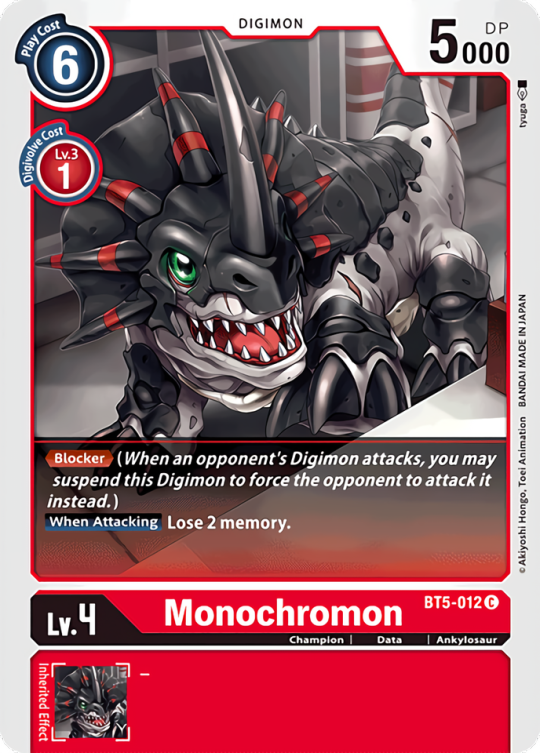
Monochromon BT5-012 by tyuga from BT-05 Booster Battle of Omni
This Monochromon card from BT5 is a reference to Digimon World's Monochromon and its shop.
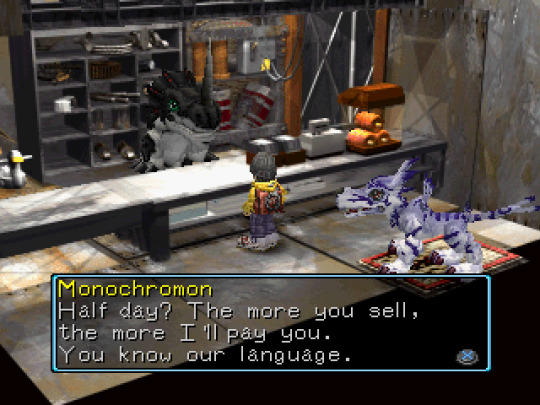
#digimon#digimon card game#digimon tcg#digica#digisafe#デジカ#digimon references#digimon world#Monochromon#tyuga#BT5#color: red#Lv4#type: data#trait: ankylosaur#num: 00
153 notes
·
View notes
Text
Large battle morph: Plains Buffalo - Able to run at up to 40mph, somewhat resistant to damage, pelt acts as armor against slashing attacks, can jump small gaps, can turn on a dime, good hearing and OK short-range eyesight, devastating headbutt attack and OK kicking attacks Small battle morph: Mountain Lion - Good medium cat, able to outrun anything that can hurt it and fight anything that can catch it. Indoor battle morph: Stronger Human - All the good traits of a human body + can still morph away injuries + doesn't stand out in crowded areas Travel morph (Aerial): Canadian Goose Travel morph (Land): Horse Travel morph (Ocean): Albatross or Arctic Tern Travel morph (Nocturnal): Canadian Goose, Albatross, and Arctic Tern are all known for flying at night.
Stealth Morph (large): That stronger human morph I mentioned earlier. Sometimes the best way to be stealthy isn't being invisible, it's just blending in. Stealth Morph (medium): Housecat - Can go almost anywhere without being suspicious, good at being quiet, good hearing Stealth Morph (small): Jumping Spider - Great eyesight, good escape mechanisms Special Mention: Crow - Crows blend in everywhere.
Aquatic morph (ocean): Shortfin Mako - Fast medium-sized shark Aquatic morph (freshwater): Lake Sturgeon- Small sturgeon with the armor and muscle of their larger cousins but able to fit in smaller bodies of water Bird of Prey morph: Red-tailed hawk - They're everywhere, they're not that unusual even in cities, they're big enough to carry cellphones
Insect Morph: Tarantula Hawk Wasp. Incapacitating but non-lethal sting, good eyesight, decent flight speed and agility.
Alien morph: Andalite
Prehistoric morph: Orthinomimus, though I wouldn't be opposed to Ankylosaurs or Bear-Dogs.
fuck Hogwarts houses, what's your MORPH
Battle morph, travel morph, stealth morph
90 notes
·
View notes
Note
I’ve had a sucky week. I know you might not see this for a while but can I please have some weird animal facts when you get a chance to answer? :]
I’m sorry your week sucked, have some TURTLES.
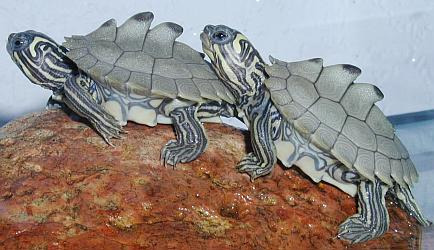
Behold: one of nature’s best examples of min-maxing.
Armor plating isn't uncommon in vertebrates. Pangolins, ankylosaurus, armadillos, and placoderms all share similar stat allocation to name a few.
Some, like pangolins, just throw all the keratin they can into their skin and end up with tough scales. That's the same stuff fingernails and hair are made of, and also the stuff that makes our skin waterproof. Others, like ankylosaurs, also grow little bits of bone into their skin. A bunch do both. These are common, efficient, easy-to-evolve traits that occur multiple times in history.
Turtles said fuck all that.
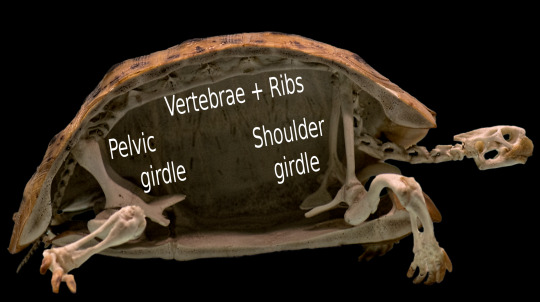
I'm doing it my way.
(Well not ALL that, they do still have keratinized scaly skin on their limbs, but still)
They took their rib cage, sternum and spinal column- you know, things that normally go inside your body, and put 'em on the outside instead. Shoulder blades and hip bones grow inside the rib cage, too. Then, as if that wasn't enough, they covered the whole deal in keratin scales. Some turtles even have a hinge on their belly (plastron) that lets them close up completely. I promise, there's a turtle in there.
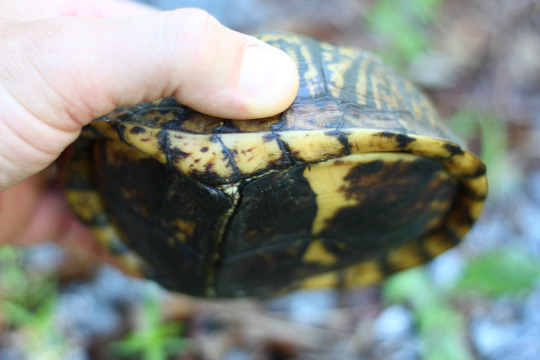
What could go wrong reverse-engineering an exoskeleton onto a vertebrate?
Turns out, a lot.
Take a nice deep breath in, and exhale it out. Can you feel your ribs move? Feel them expand and contract, working with your diaphragm muscles to pull large quantities of air into your body?
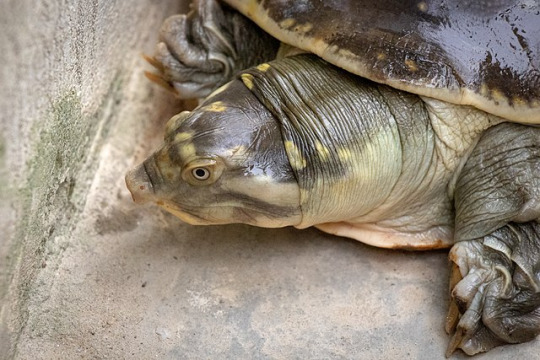
Show-off.
Yeah, when all your ribs are fused into one big dome it turns out you lose a lot of lung function. The good news? With your body fully enclosed and stabilized in bone, it's not like your abs and obliques are doing anything now. Might as well put them to work pumping your lungs. Except, not directly. Some muscles pull on the liver, which attaches to the right lung. Other muscles pull on the stomach, which pulls on the left lung. It’s pretty inefficient all around, so you may not get enough oxygen exchange to be a marathon runner, but as long as you don't have to worry about predators you know what they say about slow and steady.
However that's not always enough. What if, say, you did have to worry about predators a little. What if, hypothetically, you took a few points away from pure defense and gained a little more swim speed and mobility? You, like many semi-aquatic turtles, would need a backup source of oxygen. A breathing plan B.
In turtles, plan “B” stands for Butt. Some turtles (lots of freshwater semi-aquatic ones) can pump water in and out of their cloaca, which is sometimes enlarged and lined with specialized membranes that maximize surface area for gas exchange. Basically, improving any part of this fucked-up breathing apparatus is so difficult that it’s evolutionarily better to evolve proto-gills in the ass.
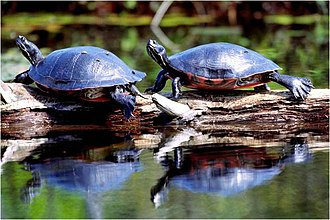
I was going to make a different joke here but these turtles are literally called “Northern Red-Bellied Cooters” and I really can’t top that
Turtles are cold-blooded, which of course means they don’t do shit in the winter. Turtles who are unfortunate enough to live in places that get winters bury themselves in the mud in a type of hibernation called ‘brumation’. You may wonder, how do they breathe THEN?
Easy, they don’t. They slow down their metabolism a crazy amount and spend the winter months doing anaerobic respiration. We can do this too, it’s why your muscles burn after working out. If your body doesn’t get oxygen, your cells can still burn fuel much less efficiently and produce a lot of lactic acid as a byproduct. Turtles can counteract the extreme acidity, buffering it and sequestering it with the bone in their shell. Literally, they leach calcium and magnesium out of their bones to prevent their acidic blood from killing them over the winter.
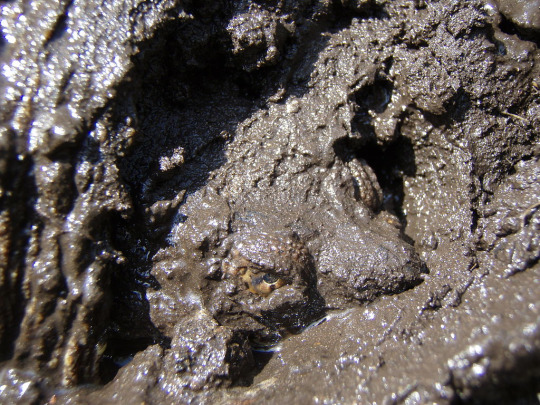
Just waking up from the winter, chock-full of acid and ready to snap.
The most infuriating thing, personally, is that all of this bullshit min-maxing works. Turtles are the longest-lived land vertebrates. The oldest recorded one lived to 187. There’s a little box turtle at my workplace that’s almost 90. This isn’t a glass cannon like a horse is, this janky tank build WORKS.
#my posts#biology#turtles#ecology#evolutionary bio#science#vertebrates#all the images are from Wikimedia commons btw#50#100#500#1k#5k
10K notes
·
View notes
Text

Ah, Velociraptor. The dromeosaur that has become a household name, thanks to the Jurassic Park series.
By now, most people know that Jurassic Park got Velociraptor wrong: it was scaled up to be more intimidating (and also to allow for a human to fit in the original costumes), it had pronated humanlike “hands” (also to allow for a manageable costume), the face was shortened and bulked up to make it seem more monitor lizard-like, and of course, it lacked feathers. These very un-raptorlike traits could be excused away by plot: the scientists who manufactured these “dinosaurs” used lizard and frog dna (for some reason) leading to scaly skin and pronated hands, and in later incarnations these iconic features were repeated to keep the raptors exciting and recognizable.
Unfortunately, as JP/JW forms the basis of most of the public’s understanding of dinosaurs, JP’s mutated version of velociraptor has bled into all forms of dinosaur media. Non-JP movies, books, art, video games, toys, even museums have been forced to present velociraptors as lizard-like movie monsters to engage the public. I like to call this version of velociraptor the Raptor™. The average person can tell you quite a bit about Raptors™, but not much about their namesake.
In reality, Velociraptor was a relatively standard dromeosaur. It was around 0.5 m (1 ft 7.5 in) tall at the hip and up to 2.07 m (6 ft 9.5 in) long. It had a long skull with a slightly upturned snout.
There were at least two species of Velociraptor: V. mongoliensis from Cretaceous Mongolia, and V. osmolskae from Cretaceous China. I have drawn V. mongoliensis here as there is a lot more material to go off of, with over a dozen specimens uncovered, including one locked in combat with a Protoceratops! This fossil is called “Fighting Dinosaurs” and is considered one of Mongolia’s national treasures. In the fossil, the Velociraptor is on its back and its right forelimb is being crushed in Protoceratops’ beak, while it slices at the Protoceratops’ neck with its feet. It is the cause of much speculation as to how these dinosaurs managed to be fossilized in this position.
As dromeosaur claws seem to be not quite sharp enough for disemboweling, It is suggested that dromeosaurs used their sickle claw for “raptor prey restraint.” In RPR the raptor would pin its prey down, using its claws to latch on tightly and balancing itself with its wings and stiff tail, then proceed to eat its prey alive. They had relatively weak jaws, so the grip of their “killing” claws, along with the force of them flapping their wings, would help pull meat from a struggling prey animal. Velociraptors also would have scavenged, as evidenced by an Azhdarchid (an animal too large for the raptor to kill) bone found in the gut of a specimen, as well as Velociraptor tooth marks on the jaw bone of a Protoceratops.
While there is some evidence of other dromeosaurs, such as Deinonychus, hunting cooperatively, there is no such evidence found for Velociraptor. All Velociraptor fossils so far have been found as isolated specimens, far from each other. For modern day raptors, the only one known to hunt cooperatively is the Harris Hawk, though Aplomado Falcons, Peregrine Falcons, and Golden Eagles will also sometimes hunt in pairs. “Pack” hunting seems to be an exception and not a rule for modern predatory dinosaurs, but it can’t exactly be ruled out for Velociraptors.
Velociraptor would have lived in an arid environment of sand dunes and intermittent streams, and most fossils seem to have been buried alive in sandstorms. The Mongolian V. mongoliensis (drawn here) would have lived alongside the ankylosaur Pinacosaurus grangeri, and (as mentioned) hunted and scavenged Protoceratops andrewsi, as well as the troodontid Saurornithoides mongoliensis, the oviraptor Oviraptor philoceratops’ chicks, and the halszkaraptorine Mahakala omnogovae, as well as small mammals, reptiles, birds, and insects.
#my art#SaritaDrawsPalaeo#Velociraptor#Velociraptor mongoliensis#dromeosaur#raptor#theropod#dinosaurs#archosaurs
609 notes
·
View notes
Text
Sunday 18/9/22 - Dinosaur Swords and Shields; Thyreophorans
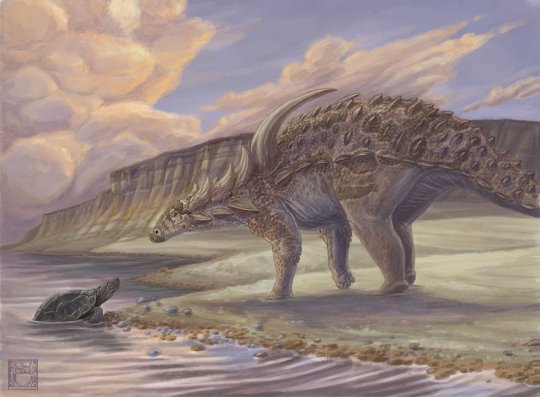
Sauropelta - Sean Closson (twitter)
Apologies in advance if today's article is a bit more scatterbrained than some of my better blogposts in the past, but I've been procrastinating writing for a bit and need to get something out.
The larger group of Dinosauria is traditionally split into two main groups: The Saurischians (lizard hips) and Ornithischians (bird hips). The Saurischians include the Therapods (most meat eaters) and Sauropods (long necks), and have been the focus of a lot of my dinosaur discussion on this blog. So today, I wanna highlight a group from Ornithischia, the Thyreophorans.

Miragaia - TheDinosaurMann (twitter)
Thyreophora includes most of what the public would think of as "Armoured Dinosaurs", and much of the uniting anatomical traits are adapted for a thick set body, weight bearing limbs, powerful tails, and a general predator deterring lifestyle. The earliest and more primitive members of this group were more slender, and evolved from a bipedal common ancestor, but the most derived members were the heaviest, spikiest, and well armoured dinosaurs of their time.

Scutellosaurus, an early Thyreophoran
Gabriel Ugueto/Serpenillus (twitter)
One anatomical trait common to all Thyreophorans is the extensive covering of Osteoderms, bony skin protrusions that decorate and protect the backs, heads, and tails of many members. In the Ankylosaur division, this is mostly present as rounded studs and lumps all along the back and sides of the animal. In Stegosaurs, they present as spikes and plates along the back and tail of the animal. Before researching this topic, it never occurred to me that these were analogous structures, but it makes sense these features had ancestral roots.
To best demonstrate the diversity of Thyreophorans, I want to highlight three of the most recent discovered species from across the group.
Bashanosaurus

@ ttorrooo (on twitter)
This Stegosaur was recently found in China in 2015 and described in 2022. Its name means "Bashan-lizard" Bashan being an old name for Chongqing, where it was discovered. Current research places Bashanosaurus as a very primitive member of the Stegosaur clade, and it shares many traits common with Scelidosaurus, a Thyreophoran thought to have evolved before Stegosaurs and Ankylosaurs diverged.
In later Stegosaurs, the back spines had evolved into angular plates, thought to be primarily a display structure. But in Bashanosaurus, the back spines are still very spiky, and parts of its body still preserve rows of spikes on the side of the body, which were reduced to just one spike on the shoulder or lost altogether in later species. It still had the tail spikes, and this seems to be an ancestral trait. It represents a visual clue on how Stegosaurs evolved some of their more derived traits.
Stegouros

@adamworks (tumblr)
This dinosaur was a very derived Ankylosaur discovered in Chile in 2018, and described in 2021. It's name means "roofed tail". Ankylosaurs were traditionally split into two groups, Ankylosauridae, many of which had tail clubs, and Nodosauridae, which were often heavier built, and lacked tail clubs. These groups were mostly from northern continents, and Ankylosaurs from Australia and Antarctica were harder to classify.
The description of Stegouros prompted the creation of a new division within Ankylosauria; Parankylosauria, a group of Gondwana dinosaurs that diverged earlier, and Euankylosauria, which included the Nodosaurids and Ankylosaurids. While the Northern Continent Ankylosaurs were larger, and utilised clubs in their tail weaponry, Stegouros and its relatives were smaller, less bulky, and Stegouros had a sword on its tail. This tail was less mobile, the "sword" formed from several fused vertebrae, but it was still very dangerous.
Jakapil
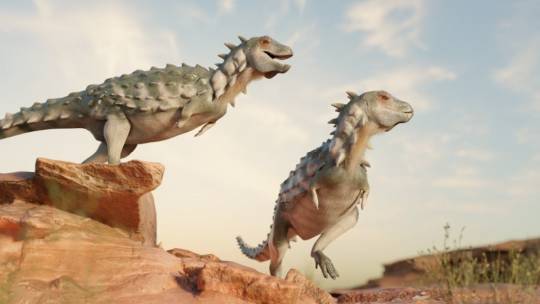
Gabriel Diaz Yantén/ PaleoGDY (on twitter)
Video version linked here
This dinosaur was a basal Thyreophoran discovered in Argentina across the 2010s and described in 2022. Its name means "shield bearer" in the Puelchan language. Jakapil represents a lineage of dinosaurs that split off from the rest of Thyreophora before Stegosaurs and Ankylosaurs even split. But whereas most of the time you'd think "basal" or "primitive" means from an older time, Jakapil was from the Late Cretaceous, after most of the Stegosaur lineage had died out.
Thyreophorans were mostly heavy set animals, so quadrupeal locomotion was the norm, but Jakapil was an obligate biped; its arms were too small to walk on. It's well muscled jaw and unique skull shape has many palaeontologists theorising it was a basal Ceratopsian, but the advanced osteoderm armour/spikes on the neck, shoulders and down the back concluded it was a Thyreophoran. A very unique dinosaur indeed.
Thanks for Reading
Hi, if you haven't read any of my stuff before, thanks for reading this. This is sort of my dive into amateur journalism. This is not a dinosaur blog, but I do talk about dinosaurs a lot, so feel free to check out the links in my Pinned Post.
If you have a suggestion for something dinosaur to talk about, please inbox me, I am starved for creativity and would love the inspiration.
#blog#blogpost#palaeontology#dinosaurs#Thyreophorans#ankylosaurs#stegosaurs#parankylosauria#bashanosaurus#stegouros#jakapil
72 notes
·
View notes
Note
Have you done an MH tree for herbivores yet, or were we just not paying attention?
I actually don’t think I will because the herbivore classification is just for “small” monsters that eat plants. It’s sort of a dubious class since technically the Blos wyverns and Gammoth would technically fall under that category.
But I can tell you what I think the various herbivores are!
Gastodon and Kestodon are technically brute wyverns related to Banbaro according to the canon trees, and honestly that actually makes quite a lot of sense and is pretty interesting so I agree! But I do have non-carnivorous brutes as heterodontosaurs.
As for the various mammals in the class… Burukku is pretty obviously a buffalo, and Erupe and Anteka are goats. Moofah seems to be a sheep. Mosswine is a pig. Kelbi actually feels like an Antilocaprid to me, which would make it related to giraffes. Popo I have as the closest living relatives of Gammoth, which together are descendants of early Proboscideans that split off from all other more “normal” members.
Epioth I actually covered in my recent tree!
Larinoth feels like a titanosaur of some kind, albeit an odd one. Both Slagtoth and Rhenoplos are ceratopsians, and Slagtoth in particular feels like a member of the Pachyrhinosaurini. Aptonoth seems to be a heavily armored Lambeosaurine. Apceros… I’m not so sure on. Ankylosaur is tempting but it’s shell is very different from them, so “Thyreophoran” is as much as I can narrow it down.
Gowngoat… I don’t know. It’s got this weird mish mash of dinosaur and goat traits. Maybe ornithopod??
#ask#questions#dappercritter#monhun#monster hunter#monsterhunter#monster hunter biology#speculative biology#speculative evolution
10 notes
·
View notes